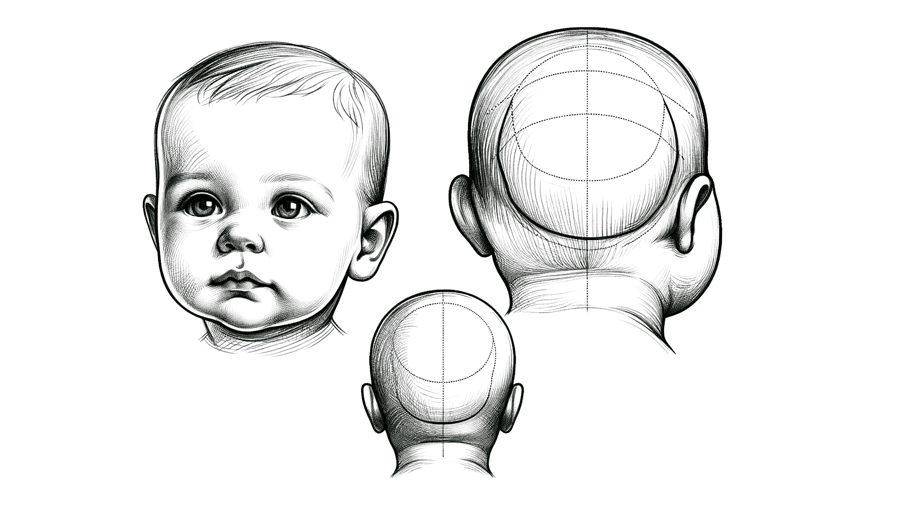Plagiocephaly Preventing Flat Head Syndrome
A common concern among new parents is the development of plagiocephaly, or ‘flat head syndrome’, in their infant. This medical term refers to an asymmetrical deformation of the skull that can occur when babies spend extended periods in the same sleeping position. Will my child’s head remain deformed, or will this issue resolve itself as they grow? Fortunately, preventive measures can be taken to reduce the risk of plagiocephaly and ensure the healthy development of your child’s head.

1. Experimenting with the belly Position:
Infants spending extended periods on their backs are susceptible to developing flat head syndrome due to the malleability of their skulls. Introducing the flat stomach position during waking phases, under active supervision, not only aids overall motor development but also serves as a protective measure against plagiocephaly. By practicing this position from birth, infants strengthen the muscles in the back of their necks, enhancing head mobility even while lying on their backs.
Welcoming a newborn into the world is a joyous occasion, but it comes with a responsibility to ensure their well-being, especially during sleep. While it’s a well-established fact recommended by pediatricians that infants should sleep on their backs, the implications of this practice go beyond simple guidance. The malleability of a baby’s head poses a risk of developing plagiocephaly, commonly known as the “flat head” syndrome. In this article, we’ll explore the challenges associated with this condition and unveil some practical tips to minimize its occurrence among infants.

2. Changing Sleeping Positions:
Plagiocephaly often develops when a baby consistently rests their head in the same position. By reversing the sleeping position, with the head where the feet were, parents can significantly reduce the risk. If your baby tends to look towards a particular direction, for example, to observe activity on their left, reversing the sleeping position encourages them to turn their head in the opposite direction. This simple adjustment is an efficient tip to combat flat head syndrome.
During sleep, babies naturally try to observe their surroundings. Reversing the sleeping position places the baby’s head in the opposite direction of their usual support, encouraging them to look the other way. This subtle change can have a significant impact on preventing plagiocephaly.

3. Specialized helmets and headbands :
The use of specialized helmets and headbands for treating plagiocephaly, or ‘flat head syndrome,’ presents a topic of ongoing debate. These devices function by altering the pressure points on an infant’s head. They increase pressure on the areas not in contact with the sleeping surface, thus reducing pressure on the flattened areas.
Typically, treatment commences when an infant is around 5-6 months old, a stage where the skull is still malleable and plagiocephaly has been identified. Despite their intended purpose, these helmets and bands come with notable drawbacks.
The cost is a significant factor, with prices around $2,000. More importantly, their effectiveness remains a subject of debate among medical professionals. Infants at this age have delicate skin, and prolonged wear of these devices can lead to skin issues, such as fungal infections due to moisture and acidity, or even allergic reactions.
Addressing the Root Causes of Plagiocephaly
Furthermore, these helmets do not address the underlying issue of reduced neck muscle tone in infants, and their weight may further burden a baby’s already disproportionate head. This complexity demands careful consideration from parents and healthcare providers alike, weighing the potential benefits against the practical and financial constraints.
Osteopathic Insights: Seeking Professional Advice
Consultation with an osteopath specializing in infants may be a valuable consideration. These specialized practitioners are adept at identifying and addressing subtle mobility issues that might not be immediately apparent. Pediatricians often have insights into early childhood professionals in your vicinity who can offer guidance. It is common to see a good improvement in the tone of the neck after consulting an osteopath. This is particularly important if your child exhibits axial hypotonia, a condition where muscle tone is reduced.
To address plagiocephaly, incorporating tummy time into the baby’s routine from an early age is crucial. Whether placing the baby on your knees or having them lie on your stomach, this tummy time should be initiated and observed with close attention to prevent any discomfort or restrictions. The frequency of these sessions plays a pivotal role in determining the speed at which the baby acquires essential motor skills, such as crawling.
Tummy Time Tactics: The First Step in Preventing Plagiocephaly
From birth, introducing tummy time—whether on your lap or while lying on your stomach—encourages the development of the muscles at the back of the baby’s neck. This increased neck muscle strength contributes to greater head mobility, even when lying on their back. It’s essential to start tummy time early and under supervision to prevent any discomfort or resistance.
Beyond Specialized Pillows: Holistic Measures for a Healthy Head Shape
Flat Head Syndrome can be a concern for parents, but with proactive measures, it’s largely preventable. From experimenting with tummy time position to changing sleeping orientations, parents have various tools at their disposal. While specialized pillows may not always provide the desired results, consulting with an osteopath can offer personalized advice. Ultimately, a combination of these strategies can contribute to a healthier head shape for your infant. Stay vigilant and consult your pediatrician for guidance tailored to your child’s unique needs.
Hair Growth and the Natural Resolution of Plagiocephaly
It’s important to note that unless there is a significant lack of axial muscle tone, these measures generally help in rectifying mild cases of plagiocephaly. In many instances, a slight flatness of the head becomes barely noticeable as it is often concealed by hair growth. Thus, while it’s essential to take proactive steps for your infant’s health, it’s also important to remember that minor cases of plagiocephaly typically don’t have long-term consequences and can be effectively managed with the right approach.
In the dynamic realm of child development, knowledge is key, and our journey through this exploration has been nothing short of illuminating. Encountering an issue with plagiocephaly prompted the discovery of an unconventional tip not covered in this article. Feel free to share your insights on how to address this concern!
This article was written by Antoine FAGET, PharmD.
